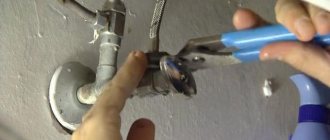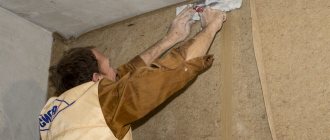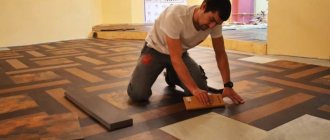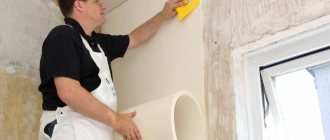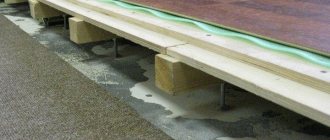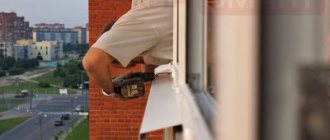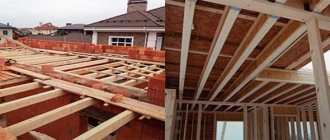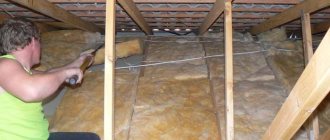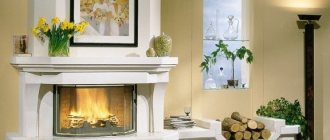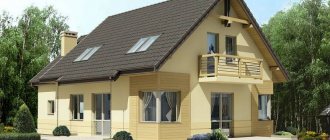You can create coziness and comfort in your home if you use high-quality and reliable sound insulation. There are many different soundproofing materials that are used today in the construction and renovation of apartments or houses. The market offers materials that differ in their characteristics, features and cost. It is quite difficult to decide on the ideal sound-absorbing fabric, because you want to get a quality product at a low price.
Photo: Felt. Author: Arthur Nokhrin
When considering various insulating materials, special attention should be paid to felt, which has all the qualities and characteristics of sound insulation. Compared to other sound insulation, purchasing felt will save up to 10% of the cost. By installing soundproofing with felt yourself, you can not only protect your home from extraneous sounds, but also save your family budget.
Types of noise
In order to choose the right soundproofing material, you need to take into account the noise efficiency, which depends on the very nature of the formation of extra decibels.
Currently, there are two types of noise: airborne and impact. The classification itself is not difficult to understand, but we will give a brief description of these types:
Airborne noise refers to excessive air vibrations that occur as a result of any mechanical action.
For example, loud music, conversation in a raised voice, breaking dishes during quarrels - all these sounds penetrate you through the openings of sockets, the ceiling, an open balcony, etc.
Impact noises come from heavy objects falling on neighbors' floors, feet stomping, furniture being rearranged, etc.
The best sound-absorbing carpets are...
Which flooring material absorbs noise best?
The thicker and denser the material, the higher its ability to soundproof. Impact noise (footsteps on the floor, falling objects) is best absorbed by needle-punched carpets. The pile of such products is fixed on the reverse side with a rubberized backing, which provides noise absorption, but such carpet is rough for residential premises. For your home, it is better to purchase a covering made using tufted or woven technology, and separately, a noise-absorbing substrate.
By the way, in the Kovrenok assortment there are many products to which a soundproofing backing is already sewn, for example, the beige-brown carpet “Vetka”, so you don’t have to buy anything in addition.
General noise in the room (voices, TV) is best dampened by floor coverings with thick, long pile. The longer and denser the pile, the better the sound insulation.
Purpose and areas of application
Acoustic felt (aka Struttofiber) is a rolled material with high density and low thickness for sealing thin sheathing and frame soundproofing structures:
- It allows you to create an excellent sound-absorbing layer for sound insulation, while the entire structure does not thicken
- Acoustic felt, in some cases suitable for finishing to improve room acoustics
- It is made from polyester (synthetic) fiber without adding any adhesives, photo above, does not contain harmful substances, unlike other construction sound insulation
Areas of application as insulation and sound absorber:
- Frame cladding of walls and ceilings made of thin timber or metal profiles with a thickness of 20 millimeters or more
- In a suspended ceiling system
- In suspended ceilings
- Walls (frame)
- Pitched roofs
- In the floors along the joists
- Humming equipment
- Wrapping large diameter pipes
- In air conditioning and ventilation systems
To improve acoustics and reduce stray resonance and echo:
- In recording studios and music studios
- In cinema premises
- In chambers with supply and exhaust units
- In server rooms
- In sololifts and pumping units
Acoustic insulation of car interiors
In car sound insulation, felt is excellent as a sound-absorbing material; in terms of its performance characteristics, it is in no way inferior to Biplast, and its price is much more advantageous:
- Sound-absorbing material made from acoustic felt in sound insulation, in addition to the main function of absorbing extraneous sounds, also automatically serves as additional electrical safety and fire safety for your car
- The use of acoustic felt in the door trim will only absorb the sound that has leaked through the previous layers of sound insulation on the door, it also allows the trim to press more tightly to the surface, which eliminates squeaks
- Technical characteristics of felt - thickness 10-20 millimeters, sheet dimensions 75x100 centimeters, there may even be an adhesive layer and moisture impregnation
Treatment areas for sound insulation in a car:
- Under plastic door trim
- Insulation of wheel arches inside the cabin
- To the ceiling
- Engine compartment bulkhead insulation
Minimum noise - maximum comfort
Recommend a more or less universal carpet made of artificial material that can be laid on the floor in any room in the apartment. I would like to decorate my home in the same style and at the same time provide sound insulation.
The request is quite general, because we do not know your requirements for the level of sound insulation, as well as on what floor the carpet will be placed (the difference between wooden and concrete floors is described above). But if we take into account the versatility and possibility of placement in any room, then we would recommend this carpet - with wear-resistant and fairly soft short pile made of synthetic material, which does not require special care and is easy to clean. This flooring provides a decent level of sound insulation for its thickness, which is quite sufficient for ordinary household needs.
Sponge rubber options
Porous foam rubber is produced in several versions.
Sheet
Using special molds, the foam material is converted into rectangular or square sheets.
The average size of foamed rubber sheets is 650 by 650 mm.
The thickness of the sheets is very different - from 5 to 45 mm.
They are used as gaskets and insulation.
The price of such material is from 250 rubles per kg.
Tape and roll
Self-adhesive insulation for doors and windows is usually made from porous rubber in the form of rolls and tapes, which can be easily connected to the surface without outside help.
To do this, simply remove the protective film from the side of the material on which the adhesive is applied. Such a tape can last for several years.
The price of ordinary rolled rubber is from 120 rubles per kg.
Corded
Foam cords are used as heat insulators and seals in a wide variety of applications. They are often made from silicone.
The price of such a product starts at an average of 70 rubles per meter.
Sound insulation in Knauf dry floors
Leveling the floor in the presence of large differences in heights
In an old housing stock, during restoration or major repairs of housing purchased in it, you may encounter huge, up to 7-8 cm, height differences in the floor slabs. Installation of a “wet” or “semi-dry” screed in such conditions can result in a huge amount of purchased material for pouring and the equipment necessary for its preparation.
It is much easier to use the dry method by filling uneven slabs with fine substances using the KNAUF Superpol system. How it's done?
- A vibration decoupler is laid around the perimeter of the room (damper tape or mineral wool in strips with a density of 70 kg/m3. (as in Fig. 4)
Rice. 4 - Beacons are placed to orientate the backfill level. Beacons are leveled.
- Between the beacons, along their upper edge, small bulk material (usually small expanded clay) up to 100 mm thick is poured, leveled and compacted.
- The beacons are carefully removed and GVLV is laid on the expanded clay substrate.
- Mineral fiber slabs are laid tightly on top of the GVLV, without gaps or deformation.
- Knauf Superpol panels are laid on top of the slabs. Where they are connected, these places are coated with glue and additionally screws for drywall are screwed into these places. The seams are sealed with putty, and the protrusions of the panels are cut off from the walls.
- A second layer of GVLV is laid on the KNAUF panels in such a way that its sheets overlap the seams of the lower level and are attached to the KNAUF panels with self-tapping screws. The seams are also sealed.
- The exhaust outlet protruding along the perimeter of the room is cut off flush.
- Apply the final “finish” coating.
Benefits of felt
Felt is perhaps one of the most common insulating materials. It has a lot of advantages, which is why it is used in various fields of industry and in particular in construction. The main advantage of this insulator is its effectiveness. Soundproofing felt has the following advantages:
- The material does not emit dust;
- Can be used in rooms with any humidity;
- Sufficiently light specific weight allows you to carry out installation work yourself;
- Easy to install, you can lay felt insulation yourself;
- Has heat and sound insulation qualities.
Using felt boards to soundproof your home, you can effectively protect your living space from sound and cold.
Conclusion
Thus, felt is the most environmentally friendly insulation material. It is capable of providing comprehensive protection for the premises. Soundproofing material is used to suppress noise in technical rooms, medical institutions and residential buildings.
The relative cheapness and availability of the material make it possible to use it in various situations and for many tasks. The advantages and useful properties of the material attract builders when constructing industrial and residential buildings.
Different types of felt are used depending on their characteristics in different situations. Equipping industrial and residential premises with combined felt can effectively solve the problems of noise insulation and fire safety.
Types of felt and advantages
Due to its porous-layered structure, felt has almost unique sound absorption properties:
- Unlike other soundproofing materials, felt not only reflects, but also absorbs any sound as much as possible.
- It does an excellent job of both suppressing external noise and suppressing internal noise inside the car.
- Technical felt is used to soundproof the doors, roof, floor in the cabin and trunk.
- Which has an excellent crease resistance, making it easy to install
- To reduce noise and vibrations coming from the bottom of the machine, it will be enough to place felt plates under rubber mats
Types of felt
When soundproofing cars, imported and domestic felt is used:
- Coarse technical felt
- Synthetic acoustic felt up to 20mm thick
- Special multi-layer felt with a soundproofing membrane
- This felt material performs an order of magnitude better at noise reduction than many advertised noise insulators.
- And the hard bottom layer also reflects acoustic waves, thus further damping extraneous sounds
- It is worth adding that the cost of felt is quite affordable, so today it is the optimal and economical solution for car sound insulation
Features that provide benefits
Acoustic insulation made from felt has many advantages:
- It is absolutely safe for the environment and humans
- It does not contain harmful substances, it does not emit an unpleasant odor or caustic dust
- High density and thickness (up to 20 millimeters), allows it to be used in frame structures
- It has good sound-absorbing properties
- It’s impossible to say for sure about moisture; felt without impregnation or sizing absorbs moisture from the air
- Has high thermal insulation properties
- It does not support combustion
- Has high strength, elasticity and wear resistance
- The instructions state that its installation does not require heating the material and the use of personal protective equipment (mask, respirator, gloves), and does not break down into shreds that are unsuitable for further use.
- Unlike mastic and bituminous materials, it is easily dismantled and can be reused
- It has an aesthetic appearance and can be used as a top layer
- Maintains properties during service life
Sound insulation with felt
The main question is why almost all car manufacturers, including well-known German companies, use felt in standard sound insulation solutions:
- The answer is obvious, because it's cheap!
- In addition, all the pieces of felt that they put at the factory inside the pillars, fenders, and other cavities of the car are usually sealed tightly in sealed plastic bags to prevent them from getting wet
- At a service station, it is unlikely that repairmen will tinker with polyethylene when installing felt sound insulation on your car.
- Saving on everything is the motto of all manufacturers, so blindly trust the choice of repairmen; it is better to purchase material and do the work yourself
- Again, when using even synthetic felt, moisture condensation cannot be avoided
- When you need the cheapest sound insulation for a car, then you can use the cheapest option - domestically produced felt
- Synthetic felt is called musical felt; it is preferable to other analogues, which is produced in huge quantities.
You can watch a video about performing felt sound insulation.
Felt to eliminate noise inside the car
Today, felt material occupies a leading place in the list of the most popular automobile sound insulators. Its high efficiency is easily explained by the layered structure of the fabric, which both reflects sound waves and absorbs them. The last property is provided by the bottom layer of felt. It has sufficient hardness to dampen extraneous noise.
In specialized stores, among the products for cars, you can see many ready-made soundproofing kits. You just need to purchase them and place them in problem areas of the car interior.
Buying felt material (not included in the kit) will cost much less - about half. To buy it for your car, you need to familiarize yourself with the classification of felt. It comes in the following types:
- technical - has a rigid structure, rather long fibers;
- special – has a thickness of more than 2 cm;
- acoustic – it is multi-layered and contains a membrane that increases the efficiency of sound insulation.
Before purchasing material to eliminate extraneous noise in the car interior, you need to assess the extent of the problem. In difficult situations, it is better to purchase the latest type of canvas. With minor noise, you can limit yourself to products of the first or second type.
Advice! I plan to soundproof the car with felt, it is advisable to purchase more expensive light-colored panels: they do not have a strong unpleasant odor.
You can perform high-quality sound insulation of a car with felt yourself, if you first select the right material Source ad-cd.net
Types of felt
Today, felt manufacturers offer various types of material that are used in one area or another. The most common is technical coarse wool felt. Insulation made from natural material is used for sound insulation of apartments, houses and public buildings.
Synthetic felt is produced using synthetic fibers and a special adhesive base. This product has high absorption rates of airborne and vibration sounds. Due to the environmental friendliness of the material, it can be used in residential areas.
Acoustic felt is made in sheets of a specific size. Its parameters are 2.5 by 1.2 meters. With density. At 1500 gr. per square meter. Due to the lightness of the sheet, you can install it yourself.
Felt with built-in membrane. The main property of this material is that, despite the small thickness of the layer, it provides a high level of protection against airborne sound. Depending on the type of room and its characteristics, you can choose the most effective sound insulation from the appropriate type of felt.
Technical rough-haired
This type of material is used as thermal insulation. Due to its light weight and good density, this insulator is very popular among modern construction companies. Plus, it has a low cost, so you can protect your home from sounds with maximum benefit.
Technical felt is produced with a thickness of 10 - 12 millimeters, so it is supplied in the form of a roll or slab. The roll is formed from a thirty-meter cloth rolled into a roll. The width of this canvas is 1.6 meters, which allows you to form sections of the required size. The sound insulation density per square meter is 1.5 kg/m2. The characteristics of felt sound insulation allow the material to be used with maximum productivity.
Acoustic felt
An acoustic felt sound insulator is used when working with frame partitions, floors and ceilings. Due to good sound absorption, the material can be used in recording studios. This insulation is often used for pitched roofs and ventilated facades. Acoustic felt can also be used to make a floating floor, which is a soundproofing substrate. This felt is made from 100% polyester fibers, so it is an environmentally friendly material that can be used for residential premises.
The dimensions of the canvas are 2.5 meters long and 1.2 wide, with a thickness of 10-12 millimeters. This type of canvas is particularly used for soundproofing the car interior.
Needle felt
This type of material is considered non-woven, and the fibers are connected to each other by piercing with special needles. Various types of fibers are used in production, due to which the material has certain characteristics and can be used not only in construction, but also in other areas of industry.
Due to the softness of needle felt, it is often used as insulation for sewing shoes and clothing. In addition, such felt can be used for the manufacture of furniture products and car insulation. Felt is produced in rolls 30 meters long, and the width of the canvas is 1.5 meters. Thanks to the soft structure of the fibers, the fiber absorbs moisture well, leaving the shoes dry.
Special felt
The main difference between the material is its composition. In the manufacture of special felt, natural and synthetic fibers are used, which makes it possible to obtain a product that well absorbs all types of sounds and noise. There are many options for the color of the canvas, which allows you to choose the shade when making tension structures.
Manufacturing technology involves the use of modern equipment and complex professional systems. Using such felt, substrates are made for floating floors and in the manufacture of suspended ceilings. This fabric is also used to equip ventilation systems and communication elements.
Soundproofing cars with building materials.
The idea itself is not new and does not belong to me. I just want to share how you can save a lot of money on soundproofing your car (if you do it yourself).
Studying materials for sound insulation, I came to the following conclusions: roughly speaking, it is divided into 2 types: vibration-absorbing and noise-absorbing, there are also additional layers, such as anti-creaking, thermal insulation. But 2 main ones must be present and they work together.
May competent specialists forgive me, I will explain how I understand the theory. Vibration dampens vibrations of metal and plastic (depending on where you glue it), due to its weight. Heavier and thicker material is more difficult to make vibrate, resonate = spread noise. Sound insulation dampens or absorbs sound waves due to its cellular structure (for example, foam rubber or felt).
I will not consider the installation technologies themselves; there are a lot of them on the Internet.
The picture is not mine from the Internet, just for understanding:
I decided to take human experience as a basis, but do it my own way. Do not use hydroisol, because This material is for external use or must be sealed very tightly, otherwise it will stink, I don’t know about the harm, but I definitely don’t want the smell of bitumen in the car.
I started looking for a tape based on butyl rubber, which turned out to be a problem in my city (Chelyabinsk). If you look, there are Guerlain, Liplent, WIPBAND and others, but they are all not in my region, and I myself did not want to bother with the delivery of a small volume (1-2 rolls). I found it in a plumbing store called soundproofing for bathtubs, sold by the meter, 200 mm wide, about 2 mm thick. I took 12 linear meters (for 4 doors) for 684 rubles. For comparison, a branded vibration would be 3 times more expensive. The only difference is that mine didn't have aluminum foil, just a type of fabric.
I wanted a Shumka made from felt, I even found somewhere to buy 10 mm thick, but they ran out there, and it was a bit expensive. I wanted to buy furniture, where they sell furniture fabrics and fillings, thin 5 mm, 2100 mm wide, 70 rubles per meter, but they sell it in rolls, 30 meters per roll, I don’t need that much. I found a 10x2 meter piece of furniture felt on Avito for 1,500 rubles.
Material separation
In turn, soundproofing materials are also divided into two types: sound-absorbing and sound-proofing, which differ from each other in their structure. Sound-absorbing material has a porous or fibrous structure, passing through which sound is first slowed down and then absorbed. For example, felt boards, cork sheets and mineral wool.
Due to the density of the structure, soundproofing material does not absorb excess noise; it completely repels it: brick, concrete and other analogues. In practice, a good effect can be achieved by combining materials of two structures, so-called sandwich panels.
Sound insulation with cement-sand screed
For the overhaul of a secondary building or furnishing an apartment in a new house for sound insulation, it is most advisable to use 1) “wet” or 2) “semi-dry” screed. Let's consider the most common second option, which is
Sound insulation using a prefabricated floating screed
A floating floor in an apartment is a labor-intensive and time-consuming process. Especially if the screed area is large. Indeed, in this case, you simply will not keep up with the process of hardening of the cement-sand mixture. Or do it in small portions, which is inconvenient and sometimes simply impossible.
- Concrete slabs, if any, are knocked off the concrete floor slabs, since they can damage the underlying sound-absorbing layer, or large potholes, crevices and cracks are sealed with small amounts of the mixture.
- The slabs are treated with an industrial vacuum cleaner.
- The perimeter of the walls is covered with damper tape, which acts as a vibration decoupler. This operation is performed instead of installing the formwork mentioned above, followed by its removal and filling the gaps left by it with sealant or foam.
- Laying a sound absorption layer. This can be glass wool, stone wool and other similar materials. The mineral fiber is placed tightly, evenly, without folds or gaps.
- A polyethylene waterproofing layer is laid with overlaps of 200 mm and an overlap of up to 100-150 mm on the walls.
- Reinforcement is laid - polyethylene or metal mesh with a mesh size of no more than 15 x 15 cm.
- They place beacons for the exact horizontal floor. Raising and lowering ridge supports for lighthouses are made from the same cement-sand mixture as the screed.
- Fill with sand-cement mortar with a thickness of at least 25 mm.
- The poured screed is compacted with a rack vibrator (a desirable operation!)
- Drying the screed. So that it does not dry too quickly, as a result of which it may crack, seal the apartment hermetically or even cover it with sheets of polyethylene or oilcloth.
- Filling with a self-leveling mixture, using a needle roller for leveling.
- Laying flooring (laminate, parquet, linoleum, etc.)
- Trimming protruding waterproofing or vibration decoupling.
- Installing skirting boards - if you already have walls ready.
It’s correct if you attach the skirting boards either to the floor or to the wall, but not to the wall and floor at the same time - otherwise they will become channels for transmitting sound from the underlying rooms!
The practice of responsible approaches to compliance with building codes suggests that the most effective are noise-insulating “pies” made from several layers of dissimilar materials, where each layer has its own function. For example, mid-frequency sound can break through the ceiling of the apartment below. But, having broken through a concrete slab, it gets stuck or dissipates in a layer of fine expanded clay with sand, its remains are absorbed with the transition of mechanical vibrations into thermal energy. The same insignificant sound impulse, which nevertheless breaks through into the overlying layers, will be reflected from the top fill and finishing coating of the floor of the apartment located above.
Rice. 2
And to jointly dampen sounds of different frequencies - medium and low, especially from the bass of subwoofers, a combination of loose layers (expanded clay, fine gravel and sand) and fibrous ones, made of mineral wool or glass wool, will serve. In the case of arranging a dry screed - OSB and loose layers of fiberboard with gluing the joints and the sheets themselves with special adhesives and treating them with mastic.
Look. What a typical broadband-spectrum sound-absorbing floor might look like (Fig. 2).
Vibration isolation is highlighted in green, it can be laid and even glued along the entire perimeter of the premises. The purpose of its installation is to prevent the passage of sounds that can be transmitted by an array of floating screed slabs to the walls.
Brown is the sound absorber itself. It can be single-layer, consisting of a scattered dry layer or fiber boards, or double-layer, where dry scattered expanded clay or something similar is poured onto a concrete slab or waterproofing. And lay mineral wool or similar material on top.
The upper sound-reflecting layer reflects those remnants of the sound wave that passed through the sound absorber and reflects the sound back into it, finally extinguishing it.
DIY installation
If you need to install soundproofing of an apartment, then first of all you need to draw up a work plan. It is not always necessary to cover all walls with a protective layer; sometimes it is enough to treat only one or two of them. In other situations, it may be necessary to think about soundproofing the floor and ceiling.
Installing a protective layer
When carrying out work, it is necessary to take into account how effective the insulation is required. Sometimes a thin layer of acoustic felt may be sufficient, but in other cases a much thicker material will be required.
It should be taken into account that there is no point in using a single layer of felt when carrying out work in an apartment. As a rule, several layers of materials are needed, each of which performs specific functions, including the final finish.
Needle felt
Therefore, you can consider two installation options:
- Use a thin layer. This is necessary if very powerful sound insulation is not needed or if the work is being carried out in a small apartment.
- Application of powerful protection. This is required where residents are constantly affected by loud noises coming from outside.
First, we will consider the procedure for carrying out work in the case when the owner needs a relatively thin protective layer for the apartment.
Noise propagation
The procedure for installing the material on the wall will be described. Installation of sound insulation is carried out as follows:
It is necessary to clean the wall of dirt, remnants of old wallpaper and other debris. If there are irregularities, cracks, or potholes, they must be carefully repaired with putty. You need to pay attention to the exit points of the pipes. There may be gaps between them and the wall that need to be sealed with acoustic sealant. Additionally, it is necessary to treat the wall with a deep penetration primer
It will seal cracks that were not previously noticed and will make the surface have higher adhesion to the coating. In addition, such treatment will serve as an obstacle to the formation of pathogenic flora. Then they use a special sound-absorbing membrane, gluing it to the surface of the wall. After this, hot fiber sheets (GFL) are installed, attaching them to the wall with special dowels and screws. Then lay a layer of self-adhesive acoustic felt. In most cases there is no need for it to exceed 1 centimeter. After this, another layer of hot fiber sheets is placed.
The total thickness of the layers with this installation method does not exceed 3.7 centimeters. Sheets of felt and gypsum fiber board should be laid so that there are no gaps between them. On the outer layer of hot fiber sheets, it is necessary to seal the cracks with putty.
On such a protective layer you can glue wallpaper or do other final finishing of the wall.
Technical felt
If a thick layer of sound insulation is required, installation will be more labor-intensive. In this case, the recommended course of action would be:
- It is necessary to prepare the wall surface. To do this, it is cleaned, potholes are sealed and treated with putty.
- Then the membrane is glued.
- The frame is installed on the wall. It can be made from a metal corner or wooden beams. In the latter case, the strength will be significantly lower. Acoustic felt is placed in it. You can use mineral wool instead, and install a layer of felt on top of the frame.
- Drywall or gypsum plasterboard can be used as the top layer. After installation, the gaps must be sealed hermetically.
This soundproofing layer can reach a thickness of seven centimeters or more. It can make the wall much thicker, but at the same time provides high-quality sound protection.
Thin layer
When installing a protective layer in the vehicle interior, self-adhesive felt for cars can be used.
In order to create comfort, a lot is needed, but good sound insulation is one of the first places. Using felt for sound insulation allows you not only to solve such problems, but also to do it at a reasonable cost.
Why do car owners install sound insulation?
There are only a few reasons that force car owners to soundproof their vehicles. Each of them provides the driver with many inconveniences.
Firstly, this is the elimination of the noise source. All kinds of creaks and rattles inside the cabin are very annoying. Constant driving in such conditions can cause disruption of the human nervous system.
Secondly, driving comfort is also affected by external sounds: most drivers often complain about annoying noise arising from studded tires.
It's also important to mention vibration. This is not the last factor that forces the driver to decide to install high-quality sound insulation in the car.
Types of felt for sound insulation
This material has several varieties:
- The most common is coarse wool felt. It is used mainly in construction. Sometimes this type is produced as self-adhesive felt, which allows you to attach it to the wall or other necessary place.
- Sometimes they produce multi-layer acoustic felt that includes a built-in membrane that enhances its sound-proofing properties.
- Needle felt is a non-woven material. In it, the fibers are fastened by piercing with special needles. This variety is widely used in sewing clothes and shoes, for the production of furniture and soundproofing the interior and trunk of a car.
- There are special types of felt. They are made using sophisticated technologies for use in certain situations (for example, as a substrate for a floating floor, for use when installing a stretch ceiling or when installing communication elements).
Typically, the thickness of coarse felt is 10-12 millimeters. One of the most famous brands is StP acoustic felt.
Why sound insulation is needed
To use as a soundproofing layer in a car interior, it is convenient to use automotive felt, which is hermetically sealed in cellophane. This is due to the ability of felt to actively absorb moisture, including from the air. This insulation is placed under the car mat and, thanks to moisture insulation, lasts for a long time without losing its quality.
Sheet 10 millimeters thick
Volkswagen Polo Hatchback ►Terka◄ › Logbook › Noise insulation part 3: floor
Good evening everyone!
While the weather was clear, I decided to roll up the floor. I’ll say right away that the article turned out to be long, because the amount of work done is enormous. Here's what came out of it:
The factory floor noise is a combination of felt and batting. This material is recycled, but despite this, it absorbs noise well.
I found traces of corrosion at the place where the driver's seat was attached. Salt deposits were found on the back of the carpet. Now it’s clear where the saffron milk caps come from. It seems like the previous owner used pile rugs in the winter. We sand the whole thing, prime it, paint it, decided to coat it with anti-corrosive on top for prevention, and washed the carpet. The seat slides were also painted; they also had traces of corrosion.
Features of felt
Speaking about the features of felt fabric, the following characteristics should be noted:
- The material is made from environmentally friendly raw materials, which allows the insulator to be used for residential and industrial premises;
- The sound insulation coefficient is very high, so it is often used in modern construction of houses and industrial buildings;
- Due to the plasticity and flexibility of the material, it can be laid on any surface, while the felt will not slip on the surface;
- Felt fabric does not rot, so it can be used in conditions of high air humidity.
- Light weight makes it easy to transport and install as sound insulation.
Technical or coarse felt is used for noise and heat insulation of residential premises, as well as industrial buildings. The manufacturing technology of coarse felt involves the use of exclusively natural raw materials without the addition of synthetics. The finished product has a high level of protection against sound and vibration waves, and also protects well from the cold.
This material is often used as insulation for public spaces: hospitals, schools, canteens and other buildings. Felt fabric is easy to cut and cut, which makes it possible to obtain absolutely any form of insulation. Felt reaches the shelves of hardware stores in rolls or slabs. Thin felt cloth is mainly rolled into rolls, while thicker felt cloth is shaped like slabs.
Carpet is not suitable for soundproofing all rooms
Are there any “contraindications” for laying carpet on the floor in a room? What determines its service life? Is it true that long-pile carpet absorbs noise better than short-pile carpet?
First of all, you need to choose the right carpet - in accordance with where it will be located. For example, a long-pile floor covering that provides excellent sound insulation is inappropriate in the hallway, as it will wear out quickly. Its place is in the bedroom or children's room, where it will absorb the noise of footsteps. And yes, long pile does provide better sound insulation. But for a hallway or living room, a carpet with a short and fairly hard pile is suitable, which, thanks to the synthetic material, is abrasion-resistant, easy to clean and provides sufficient sound insulation.
The fact that the floor should be level has already been mentioned above. Let us only clarify that you can check this using a building level or a long lath - there should not be large gaps between it and the floor, 2 mm is the permissible maximum. If this condition is not met, the carpet, regardless of the material it is made of, will lie unevenly or will wear out faster and become damaged in uneven areas. We have also already talked above about methods for obtaining a level floor with or without a screed, as well as the materials necessary for this.
If we talk about where it is undesirable to place carpet for sound insulation, then such rooms actually exist. This is a bathroom and a kitchen. Regardless of the material, carpet does not tolerate high humidity, so it is better not to place it on the bathroom floor. It can be used in the kitchen, but it will last noticeably less than in any other living room. Therefore, if you still decide to provide sound insulation in the kitchen, you can take some inexpensive carpet.
Specifications
This material is made from the wool of certain breeds of sheep, as well as from polyester fiber, which has similar qualities. No adhesives are added to its composition. Felt material has good mechanical strength, elasticity and durability. Throughout the entire period of use, the material fully retains its beneficial properties.
Soundproofing the wall
Soundproofing felt has a fibrous structure and is able to actively absorb moisture and retain it inside. Once the sheet gets wet, its soundproofing properties deteriorate significantly.
The density of coarse felt is 1500 grams per square meter. It is most often produced in the form of sheets measuring 2.5x1.2 meters.
Ceiling soundproofing
Additional Information! This material is not fire hazardous and is not prone to rotting. Felt can not only reflect sound, but also absorb it. One of its important features is environmental friendliness and hypoallergenicity. If you use this material, even people suffering from allergies will not experience any inconvenience from it. When used, this material does not leave debris, separate fibers and does not emit dust.
The use of felt is also beneficial because it is cheaper compared to other soundproofing coatings.
Acoustic felt has high creasing properties. This allows it to be installed in hard-to-reach places and where there are sharp corners or a surface of complex shape, and can be easily positioned in the car interior.
In addition to protecting against noise, the material has good thermal insulation properties.
The lightweight felt makes it easy to transport and install.
Sound-absorbing felt
What kind of carpet to lay on the floor for good sound insulation?
Constant noise is a serious problem for any person living in a multi-storey building, because the level of sound insulation in this case leaves much to be desired.
And in order not to cause inconvenience to residents on the floor below, it is worth taking care of good soundproofing of the floor. This is especially true if you have noise sources such as children or large dogs, or if you like to exercise in the morning. Carpet, like linoleum, is a so-called soft floor - a noise-absorbing floor covering that helps achieve a certain degree of sound insulation without the use of additional materials. At the same time, carpet can be different, and then we will consider which option can be chosen for soundproofing an apartment using the example of questions we receive from clients.
Production
Felt is made using sheep wool. The production technology includes the process of felting raw materials, due to which the fibers are twisted together, forming a dense fabric. Felt fabric is produced both in rolls and slabs. In addition, felt can have different colors and technical characteristics, which can be selected according to certain criteria.
Modern felt manufacturing technologies allow the use of synthetic fibers, which have characteristics similar to woolen material. Synthetic felt is distinguished by its strength and durability, while the insulation parameters remain the same.
Execution of work
Processing the bottom and wheel arches
These works will slightly reduce the noise level in the car, but it is better to carry them out first to additionally protect the car from corrosion. Before starting work, the surfaces to be treated are thoroughly washed using car shampoo.
Next, the surfaces are dried using compressed air or an industrial hair dryer.
The surfaces are inspected and all corrosive deposits and rust are removed using abrasives or a rust converter. The surface is degreased and mastic is applied using a spray bottle or an ordinary brush.
Soundproofing MaxForte
This type of sound insulation is used in conjunction with the floating screed method - as one of its options. And, like any material, MaxForte has its own installation features.
The peculiarity of using this type of sound insulation is that the roll must be spread strictly with the soft side facing the floor, facing the walls; after all work is completed, the excess will be cut off. The joints between the spread strips of material are coated with liquid rubber Hydrostop MaxForte.
What are the benefits of using MaxForte soundproofing material?
Impact noise is reduced by 27 dB; due to the presence of plasticizers in the material, it does not tear or crack; the material is waterproof, which means it can also be used as a waterproofing agent; sound absorption class – highest (“A”, i.e. fifth out of five possible); MaxForte is used both for dry screed and directly under rigid laminate.
Nuances worth knowing
- How to soundproof a floor in an apartment or house with wooden floors? Soundproofing a wooden floor is more expensive than a concrete floor - due to the need to install strong wooden joists and order a special floorboard.
- If communications are laid under the floor, they must be insulated with a special elastic material.
- Skirting boards are attached either to the wall or to the floor (preferably the former). Otherwise, they become a conductor of noise both from below and from the sides.
- Be sure to check the certification of soundproofing materials according to building codes. And the point is not even in the possible poor quality of sound insulation, but also in that. That “left-handed” materials can pose a danger to life by emitting toxic volatile substances.
